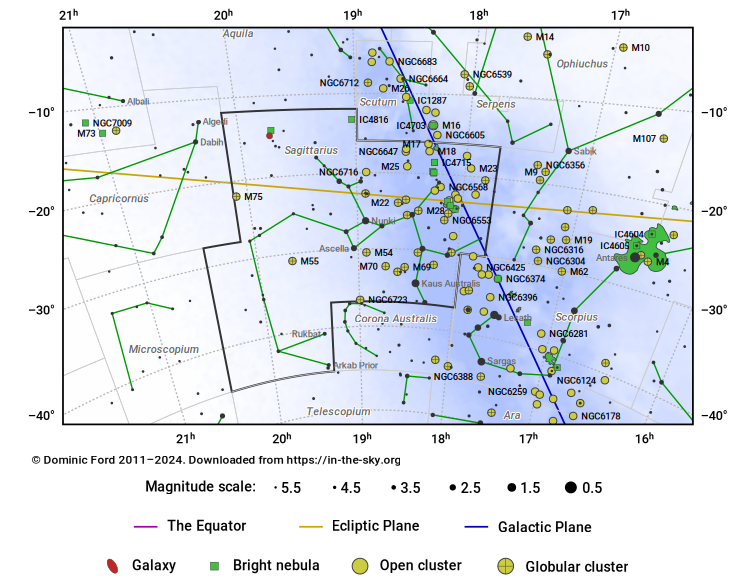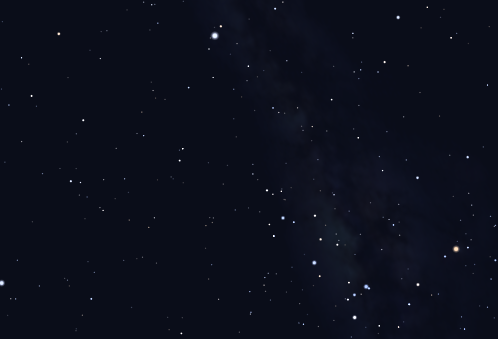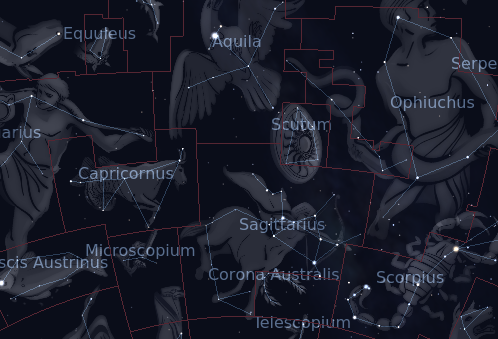The Constellation Sagittarius
Sagittarius is a large southern constellation which spans the declination range δ=12°S to δ=45°S. It appears highest in the evening sky in the months around July.
This area of the sky looks directly towards the center of the Milky Way, which is marked by the radio source Sgr A. This makes it the richest of all the constellations for deep sky objects, including no fewer than fifteen open clusters and eighteen globular clusters brighter than tenth magnitude. Among these is M22, the fifth brightest globular cluster in the sky.
It is also home to the diffuse ninth-magnitude galaxy NGC 6822, also known as Caldwell 57.
Sagittarius is one of the twelve members of the zodiac, and the Sun passes through it each year between mid-December and mid-January.
Sagittarius is usually depicted as a centaur (half horse, half man) holding a bow and arrow. The constellation is of Sumerian origin and was subsequently adopted by the Greeks, leading to some uncertainty over the archer's identity. According to Eratosthenes, the archer is Crotus, nurse to the Muses and the inventor of archery. However, this association is problematic as Crotus was not a centaur, but rather a satyr.
Ancient
2.1% of the sky
867.4 square degrees
Sagittarius contains the following Messier objects: M8, M17, M18, M20, M21, M22, M23, M24, M25, M28, M54, M55, M69, M70, M75.
The following constellations neighbor Sagittarius: Aquila, Capricornus, Corona Australis, Indus, Microscopium, Ophiuchus, Scorpius, Scutum, Serpens Cauda, Telescopium.
Hover the pointer over the name of an object to highlight its position on the starchart to the right, or click to see more information.
| Stars | Open Clusters | Globular Clusters | Galaxies |
| Kaus Australis (mag 1.8) | NGC 6530 (mag 4.6) | Messier 22 (mag 5.2) | NGC 6822 (mag 9.3) |
| Nunki (mag 2.1) | Messier 25 (mag 4.6) | Messier 55 (mag 6.3) | IC 4991 (mag 11.5) |
| Ascella (mag 2.6) | Messier 23 (mag 5.5) | NGC 6723 (mag 6.8) | IC 4931 (mag 11.9) |
| Kaus Media (mag 2.7) | Messier 21 (mag 5.9) | Messier 28 (mag 6.9) | IC 4946 (mag 11.9) |
| Kaus Borealis (mag 2.8) | Messier 17 (mag 6.0) | NGC 6544 (mag 7.5) | NGC 6849 (mag 12.1) |
| π-Sgr (mag 2.9) | Messier 20 (mag 6.3) | NGC 6624 (mag 7.6) | NGC 6835 (mag 12.5) |
| Alnasl (mag 3.0) | Messier 18 (mag 6.9) | Messier 54 (mag 7.7) | NGC 6841 (mag 12.6) |
| η-Sgr (mag 3.1) | NGC 6716 (mag 7.5) | Messier 70 (mag 7.8) | NGC 6890 (mag 12.7) |
| φ-Sgr (mag 3.1) | NGC 6520 (mag 7.6) | NGC 6553 (mag 8.3) | NGC 6816 (mag 12.9) |
| τ-Sgr (mag 3.3) | NGC 6546 (mag 8.0) | Messier 69 (mag 8.3) | NGC 6794 (mag 12.9) |
| ξ²-Sgr (mag 3.5) | NGC 6647 (mag 8.0) | NGC 6569 (mag 8.4) | NGC 6836 (mag 13.0) |
| O-Sgr (mag 3.8) | NGC 6469 (mag 8.2) | NGC 6652 (mag 8.5) | NGC 6806 (mag 13.2) |
| μ-Sgr (mag 3.8) | NGC 6645 (mag 8.5) | NGC 6558 (mag 8.6) | NGC 6878 (mag 13.2) |
| ρ¹-Sgr (mag 3.9) | NGC 6568 (mag 8.6) | Messier 75 (mag 8.6) | NGC 6902 (mag 13.8) |
| Rukbat (mag 3.9) | NGC 6507 (mag 9.6) | NGC 6642 (mag 8.9) | IC 4926 (mag 13.9) |
| Arkab Prior (mag 3.9) | NGC 6583 (mag 10.0) | NGC 6717 (mag 9.3) | IC 4913 (mag 14.0) |
| ι-Sgr (mag 4.1) | NGC 6603 (mag 11.1) | NGC 6522 (mag 9.5) | IC 4998 (mag 14.0) |
| Arkab Posterior (mag 4.3) | NGC 6774 | NGC 6638 (mag 9.7) | NGC 6805 (mag 14.3) |
| θ¹-Sgr (mag 4.3) | NGC 6737 | NGC 6440 (mag 10.1) | IC 1309 (mag 15.1) |
| IC4816 (mag 4.5) | NGC 6698 | NGC 6528 (mag 10.7) | |
| V3872 Sgr (mag 4.5) | NGC 6596 | NGC 6540 (mag 14.6) | |
| b¹-Sgr (mag 4.5) | NGC 6561 | ||
| HIP 88839 (mag 4.6) | NGC 6554 | ||
| υ-Sgr (mag 4.6) | NGC 6506 | ||
| X Sgr (mag 4.6) | |||
| h²-Sgr (mag 4.6) | |||
| HIP 89678 (mag 4.7) | |||
| W Sgr (mag 4.7) | |||
| ω-Sgr (mag 4.7) | |||
| 4-Sgr (mag 4.7) |




